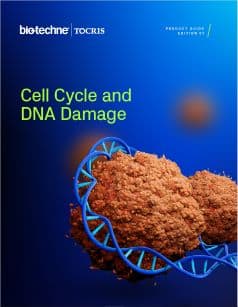Calpains
Calpains are a group of calcium-sensitive cysteine proteases that are ubiquitously expressed in mammals. Structurally, calpains contain two subunits; an 80 kDa catalytic subunit and a 28 kDa regulatory subunit that functions as a chaperone to stabilize the 80 kDa structure.
Calpain Inhibitors |
|
|---|---|
| Cat. No. | Product Name / Activity |
| 5208 | E 64 |
| Potent and irreversible cysteine protease inhibitor | |
| 7496 | FMK 9a |
| Potent calpain inhibitor; also inhibits autophagin-1 and cathepsin B | |
| 1748 | MG 132 |
| Proteasome and calpain inhibitor. Inhibits NF-κB activation | |
Calpains are a group of calcium-sensitive cysteine proteases that are ubiquitously expressed in mammals. This family contains 14 members, with μ-calpain (calpain 1) and m-calpain (calpain 2) being the most well-characterized. Structurally, calpains contain two subunits; an 80 kDa catalytic subunit and a 28 kDa regulatory subunit that functions as a chaperone to stabilize the 80 kDa structure.
Calpains are regulated by Ca2+ concentration, phosphorylation, calpastatin and probably by altering their subcellular localization (limiting access to substrate). These endopeptidases have numerous functions including, but not limited to, remodeling of cytoskeletal attachments to the plasma membrane during cell fusion and cell motility, proteolytic modification of molecules in signal transduction pathways, degradation of enzymes controlling progression through the cell cycle, regulation of gene expression, substrate degradation in some apoptotic pathways, and an involvement in long-term potentiation.
Perturbations in calpain activity have been associated in pathophysiological processes contributing to type II diabetes (calpain 10), Alzheimer's disease (calpain 1), gastric cancer (calpain 9) and muscular dystrophy (calpain 3).
External sources of pharmacological information for Calpains :
Literature for Calpains
Tocris offers the following scientific literature for Calpains to showcase our products. We invite you to request* your copy today!
*Please note that Tocris will only send literature to established scientific business / institute addresses.
Cell Cycle and DNA Damage Research Product Guide
This product guide provides a review of the cell cycle and DNA damage research area and lists over 150 products, including research tools for:
- Cell Cycle and Mitosis
- DNA Damage Repair
- Targeted Protein Degradation
- Ubiquitin Proteasome Pathway
- Chemotherapy Targets
Pathways for Calpains
Apoptosis Signaling Pathway
Apoptosis is a physiological process for cell death that is critical during aging and development. It may also be referred to as cell 'suicide'. Apoptosis can be triggered by events both inside and outside of the cell.Calpain Gene Data
| Gene | Species | Gene Symbol | Gene Accession No. | Protein Accession No. |
|---|---|---|---|---|
| Calpain 1 | Human | CAPN1 | NM_005186 | P07384 |
| Mouse | Capn1 | NM_007600 | O35350 | |
| Rat | Capn1 | NM_019152 | P97571 | |
| Calpain 2 | Human | CAPN2 | NM_001748 | P17655 |
| Mouse | Capn2 | NM_009794 | O08529 | |
| Rat | Capn2 | NM_017116 | Q07009 | |
| Calpain 3 | Human | CAPN3 | NM_000070 | P20807 |
| Mouse | Capn3 | NM_007601 | Q64691 | |
| Rat | Capn3 | NM_017117 | Q9R113 | |
| Calpain 5 | Human | CAPN5 | NM_004055 | O15484 |
| Mouse | Capn5 | NM_007602 | O08688 | |
| Rat | Capn5 | NM_134461 | Q8R4C0 | |
| Calpain 6 | Human | CAPN6 | NM_014289 | Q9Y6Q1 |
| Mouse | Capn6 | NM_007603 | O35646 | |
| Rat | Capn6 | NM_031808 | O88501 | |
| Calpain 7 | Human | CAPN7 | NM_014296 | Q9Y6W3 |
| Mouse | Capn7 | NM_009796 | Q9R1S8 | |
| Rat | Capn7 | NM_001030037 | Q499T5 | |
| Calpain 8 | Human | CAPN8 | XM_001128157 | A6NHC0 |
| Rat | Capn8 | NM_133309 | Q78EJ9 | |
| Calpain 9 | Human | CAPN9 | NM_006615 | O14815 |
| Rat | Capn9 | XM_341719 | O35920 | |
| Calpain 10 | Human | CAPN10 | NM_023083 | Q9HC92 |
| Mouse | Capn10 | NM_011796 | Q9ESK3 | |
| Rat | Capn10 | NM_031673 | Q767K2 | |
| Calpain 11 | Human | CAPN11 | NM_007058 | Q9UMQ6 |
| Mouse | Capn11 | NM_001013767 | Q6J756 | |
| Rat | Capn11 | NM_001002806 | Q4V8Q1 | |
| Calpain 12 | Human | CAPN12 | NM_144691 | Q6ZSI9 |
| Mouse | Capn12 | NM_001110807 | Q9ER56 | |
| Rat | Capn12 | NM_001110808 | XP_218460 | |
| Calpain 13 | Human | CAPN13 | NM_144575 | Q6MZZ7 |
| Mouse | Capn13 | NM_001033444 | Q3UW68 | |
| Rat | Capn13 | NM_001025133 | Q5BK10 | |
| Calpain 14 | Human | CAPN14 | XR_017761 | A8MX76 |

